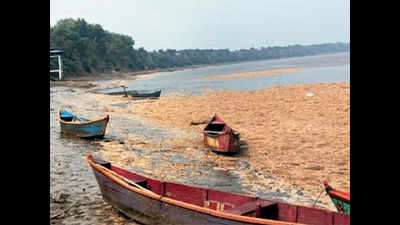- News
- City News
- vadodara News
- Vadodara: More toxic effluents on Mahisagar riverbank renew old worries
Trending
This story is from December 14, 2020
Vadodara: More toxic effluents on Mahisagar riverbank renew old worries
For the second time within a month, thick layers of yellow-white foam, visibly toxic, started floating on the surface of Mahisagar river on the outskirts of the city raising serious concerns on Sunday.

GPCB teams have been collecting samples from the bank of the river
VADODARA: For the second time within a month, thick layers of yellow-white foam, visibly toxic, started floating on the surface of Mahisagar river on the outskirts of the city raising serious concerns on Sunday.

Like on the day of Diwali, the froth was found floating on both the sides of the river at Kareli, Dabka, Mujpur and Umaraya villages located just 25 km away from Vadodara.
Gujarat Pollution Control Board (GPCB) reached collected samples, but environment activists have demanded continuous monitoring for three months. “Mahisagar river is in ICU. It is no longer a question of some villages located on the banks of the river. If nothing is done now, it will damage Vadodara’s water sources,” said Rohit Prajapati of Paryavaran Suraksha Samiti (PSS).
“Mahisagar is a perennial river. So, there should be no COD while its DO should be around 7. The high COD level and low DO level speaks of the disastrous damage to the river,” said Prajapati.
PSS believes that the confluence of the Mahi river and the Effluent Channel Project (ECP) at ‘J Point’ in the Gulf of Khambhat is in very close proximity to that of the Sabarmati river, which also carries high concentration of sewage and industrial effluents that gets dumped into the Gulf.
“This confluence is particularly alarming and worrisome as we fear that the tidal activities in the Gulf of Khambhat, drive the highly toxic and polluted waters inland at the estuaries of the Mahi and Sabarmati rivers. This is causing tremendous risk to settlements, villages and towns in the region,” PSS representation to all authorities concerned reads.
“We believe this is the result of continuous and voluminous discharge of effluents and sewage over a period three decades, which may form toxic sediments in stretches along Gulf of Khambhat, particularly near the estuaries,” it stated.

Like on the day of Diwali, the froth was found floating on both the sides of the river at Kareli, Dabka, Mujpur and Umaraya villages located just 25 km away from Vadodara.
Gujarat Pollution Control Board (GPCB) reached collected samples, but environment activists have demanded continuous monitoring for three months. “Mahisagar river is in ICU. It is no longer a question of some villages located on the banks of the river. If nothing is done now, it will damage Vadodara’s water sources,” said Rohit Prajapati of Paryavaran Suraksha Samiti (PSS).
Samples that were collected on November 14 revealed that the chemical oxygen demand (COD) of the river is 170 mg/ litre while dissolved oxygen (DO) is 2.93 mg/ litre.
“Mahisagar is a perennial river. So, there should be no COD while its DO should be around 7. The high COD level and low DO level speaks of the disastrous damage to the river,” said Prajapati.
PSS believes that the confluence of the Mahi river and the Effluent Channel Project (ECP) at ‘J Point’ in the Gulf of Khambhat is in very close proximity to that of the Sabarmati river, which also carries high concentration of sewage and industrial effluents that gets dumped into the Gulf.
“This confluence is particularly alarming and worrisome as we fear that the tidal activities in the Gulf of Khambhat, drive the highly toxic and polluted waters inland at the estuaries of the Mahi and Sabarmati rivers. This is causing tremendous risk to settlements, villages and towns in the region,” PSS representation to all authorities concerned reads.
“We believe this is the result of continuous and voluminous discharge of effluents and sewage over a period three decades, which may form toxic sediments in stretches along Gulf of Khambhat, particularly near the estuaries,” it stated.
End of Article
FOLLOW US ON SOCIAL MEDIA










